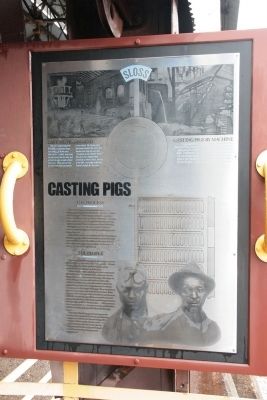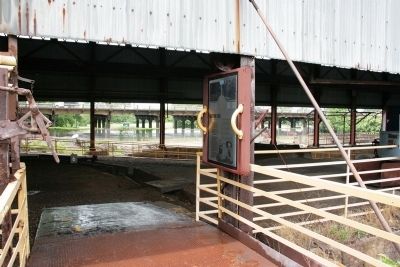Birmingham in Jefferson County, Alabama — The American South (East South Central)
Casting Pigs
Sloss Furnaces National Historic Landmark
The Process
The technology of casting molten iron into bars called pigs changed dramatically over the years. Prior to 1931 casting at Sloss took place inside the cast shed. Men cut molds into the sand floor of the shed, allowing the molten iron to pour through the channels and into individual molds. The configuration of molds feeding off troughs gave rise to the term "pig" for the bar of iron—workers thought the molds resembled pigs suckling at the sow.
After 1931 casting was mechanized. Iron flowed from the furnace, down the curved runner and into the ladle car outside the shed. The ladle car then moved down the tracks to the pig casting machine, the remains of which you can see straight ahead.
The People
The men who broke up and carried out the iron from the sand casting beds were called iron carriers. Edward Uehling, inventor of the mechanical pig casting machine, described their work this way: "When the iron had cooled down to the temperature of solidification, but was still red hot, the iron carriers began their task. They covered the pigs with a layer of sand, then put on shoes with thick wooden soles, walked on the hot iron, and with crowbars broke the pigs off the sow and with sledge hammers broke the sow into pieces the length of the pigs. This was as hot a job as a man could stand, but it had to be done. If the pigs were allowed to get cold, it would not only be more difficult to break the pigs off the sow and the sow pieces, but the iron could not be carried away in time to mold up [the sand] for the next cast...Only one man in ten is physically fit to be an iron carrier, and the best of them cannot stand up under the strain for many years...
The task of breaking up and carrying out the iron from the casting beds of even modest-size furnaces is not a fit one for human beings. If it were possible to employ horses, mules or oxen to do this work, the Society for the Prevention of Cruelty to Dumb Animals would have interfered long ago, and rightfully so."
Erected by Sloss Furnaces National Historic Landmark.
Topics. This historical marker is listed in this topic list: Industry & Commerce. A significant historical year for this entry is 1931.
Location. 33° 31.235′ N, 86° 47.444′ W. Marker is in Birmingham, Alabama, in Jefferson County. Marker can be reached from the intersection of 32nd Street North and 2nd Avenue North, on the left when traveling north. This marker is located on the grounds of the Sloss Furnaces National Historic Landmark. Touch for map. Marker is at or near this postal address: 20 32nd Street North, Birmingham AL 35222, United States of America. Touch for directions.
Other nearby markers. At least 8 other markers are within walking distance of this marker. The Stock Trestle (here, next to this marker); The Blast Furnace (a few steps from this marker); Stock Trestle/Tunnel (a few steps from this marker); Slag (within shouting distance of this marker); The Gas System (within shouting distance of this marker); Racial Terrorism and Convict Leasing / Racial Violence at Brookside Mines (within shouting distance of this marker); Boilers (within shouting distance of this marker); Ironmaking (within shouting distance of this marker). Touch for a list and map of all markers in Birmingham.
More about this marker. This marker can be found outside of Furnace Number 1's casting shed, south of the furnace.
Also see . . . Sloss Furnaces National Historic Landmark. Site homepage (Submitted on October 7, 2013.)
Credits. This page was last revised on January 22, 2021. It was originally submitted on October 6, 2013, by Timothy Carr of Birmingham, Alabama. This page has been viewed 818 times since then and 63 times this year. Photos: 1, 2. submitted on October 6, 2013, by Timothy Carr of Birmingham, Alabama. • Bernard Fisher was the editor who published this page.

